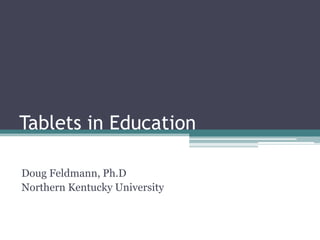The Future of Tablets New Orleans- Doug Feldman
- 1. Tablets in Education Doug Feldmann, Ph.D Northern Kentucky University
- 2. A little about meŌĆ” ŌĆó Associate Professor, College of Education ŌĆō NKU ŌĆó Datacaster, Major League Baseball
- 3. ŌĆ£Cultural LagŌĆØ ŌĆó Gap between technology capability in society and in public schools ŌĆó ŌĆ£Rip Van Winkle SyndromeŌĆ”ŌĆØ
- 4. Another Gap ŌĆō in Teacher EducationŌĆ” ŌĆ”between ŌĆ£wowingŌĆØ students with the university technology, and what they find in P-12 classrooms (makes you wonderŌĆ” is funding public schools really a priority in this country?)
- 5. What Teachers WantŌĆ” ŌĆ” to foster creative and critical thinking skills in their students ŌĆ”not possible in the current environment (The publicŌĆÖs love affair with standardized test scores)
- 6. Can Tablets Help in this Dilemma? Yes! They already haveŌĆ”
- 7. The Predecessor ŌĆō PDAs (examples) ŌĆó Gym Teachers taking attendance ŌĆó Student Teachers taking notes in the field (remember ŌĆ£scriptingŌĆØ with the stylus???)
- 8. Tablets at Work in Schools TodayŌĆ” ŌĆó Notre Dame Academy ŌĆō Covington, KY Ō¢½ A school without textbooksŌĆ” ŌĆó Lehmann Center, Lakewood, NJ Ō¢½ A special-needs school Ō¢½ Address studentsŌĆÖ motor skill difficulties (example ŌĆō Guitar App ŌĆō produces music with limited touching of the screen)
- 9. Pros and ConsŌĆ” (from the teacher/professor standpoint)ŌĆ” On the plus sideŌĆ” ŌĆó No clicking! ŌĆó No hiding behind laptop lids! ŌĆó Easy to add last-minute course changes On the negative sideŌĆ” ŌĆó No ŌĆ£saveŌĆØ button is alarming to students ŌĆó Note-taking on the keyboard can be cumbersome
- 10. What does the future hold? ŌĆó Apps are beginning to dominate education ŌĆó More emphasis placed on tablets than any other hardware Ō¢½ Already seen in MLB - #1 mobile sports app; enhanced for tablets










